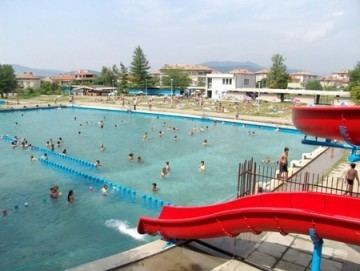Local time Saturday 4:33 AM | ||
 | ||
Weather 6°C, Wind NW at 6 km/h, 82% Humidity | ||
Pavel Banya (Bulgarian: Павел Баня) is a small town in Stara Zagora Province, South-central Bulgaria, located between the towns of Kalofer and Kazanlak. It is the administrative centre of the homonymous Pavel Banya Municipality. As of December 2009, the town has a population of 2,918 inhabitants. The place is famous for its mineral springs.
Contents
- Map of 6155 Pavel Banya Bulgaria
- Geography
- Climate
- History
- Religion
- Politics
- Landmarks
- Economy
- Environment Daily Life and Activities
- Events
- Resorts and Spas
- References
Map of 6155 Pavel Banya, Bulgaria
Geography
Pavel Banya is located 24 kilometers west of Kazanlak, neighboring Koprinka Reservoir. The town is situated in the central part of Bulgaria, between the Balkan Mountains and the Sredna Gora in the Rose Valley, near the Tundzha River. It is 22 km west of Kazanlak and 185 km east of Sofia. Some archeological finds include the tomb of the Thracian king Sevt III in the Golyama Kosmata and the tomb of the Thracian king Ostrusha.
Climate
Since it is 400 meters above sea level, the small town of Pavel Banya has a continental mediterranean climate. Pavel Banya enjoys warm summers, with an average of 22 degrees (72 degrees Fahrenheit) Celsius in July, and colder winters, with an average of 1 degree Celsius (34 degrees Fahrenheit) in January.
History
Pavel Banya is a relatively new community. It was founded after Bulgaria was freed from Ottoman rule in 1878. The remains of early Orthodox Christian churches have been discovered, along with Roman baths. It was named after St. Pavel (Paul) and Prince Pavel, the Russian Tsar-Liberator's brother.
Religion
People of different religions live in Pavel Banya. The various religious holidays are respected by the populace. There is a Bulgarian Orthodox church in the town. Although there is no mosque in Pavel Banya itself in the municipality, several of the surrounding villages, some of which are entirely or almost entirely ethnically Turkish, do have mosques. Many inhabitants of Pavel Banya are Turkish, and are therefore Muslim. They speak Bulgarian as well as Turkish, and are respected. They come to and live in Pavel Banya so they can enjoy the natural mineral water for purposes including drinking and bathing.
Politics
All Bulgarian political parties are represented in local politics. The mayor of the municipality, Stanimir Radevsky, was elected as an independent candidate. The two vice-mayors are from the Union of Democratic Forces and the Movement for Rights and Freedoms, respectively.
Landmarks
Other than its fresh mineral water, Pavel Banya municipality is an appreciated Bulgarian town because of its variety of valuable landmarks in its area:
- Ethnographic collection containing folk style items used during the end of the 19th and the beginning of the 20th century
- Old rose-oil distillation installation used some 350 years ago
- Modern rose-oil distillery
- Park planted with decorative roses
- Places for relaxation (alcoves, walk alleys)
Economy
Pavel Banya's economy is based on hydrotherapy tourism and cultivation of flower oils (lavender, Kazanlak roses, and salvia). Rose oil production in Pavel banya Municipality is one of the main sectors of the local economy. On municipal territory there are 9 active distillery and over 5,000 acres (2,023 ha) rose plants.
Environment, Daily Life, and Activities
Pavel Banya consists mainly of rocky roads and gardens, surrounding a busy and bustling town square. Citizens often ride bicycles, walk around, and shop in the town center. Stray dogs and cats can be found at every corner, though most people take some dogs and cats in as their own, or feed them daily at a certain time. Because the inhabitants of Pavel Banya are not accustomed to internet devices, children are often seen playing outside.
Events
A unique three-day feast is organized annually in the first days of June – The Rose and Mineral Water Festival. The festivities are very popular among Bulgarians and foreigners alike. The program includes an international folk festival, opening of the swimming season, rose picking, and a carnival; the festival culminates in selecting the Queen Rose. The culmination of the celebration is on the last day, when the ritual "Rose picking" and rose oil distilling are presented in traditional and modern techniques, then a spectacular procession of all participants in the celebration passes on the streets. The Feast takes place every year within three days the end of the second week of June.
Resorts and Spas
Several hotels and spas can be found in Pavel Banya, containing large amounts of its famous mineral water. Nearly every spa has pools and other water facilities containing mineral water from the natural springs.
